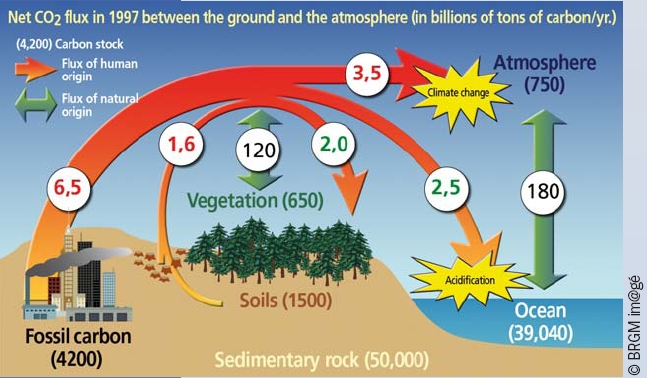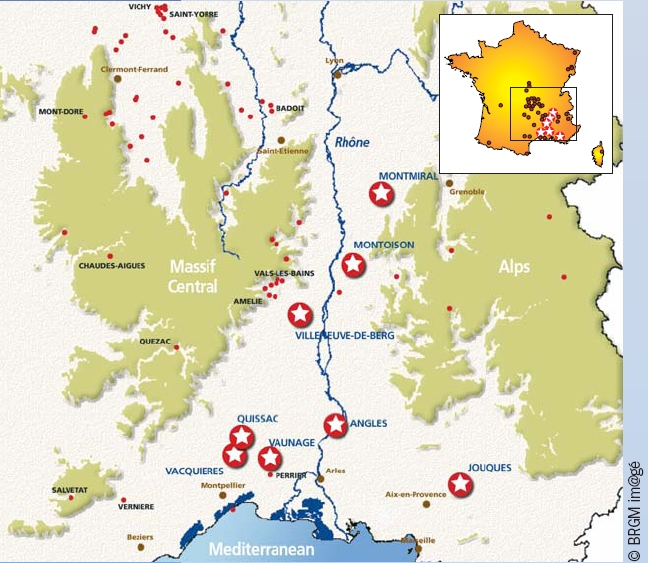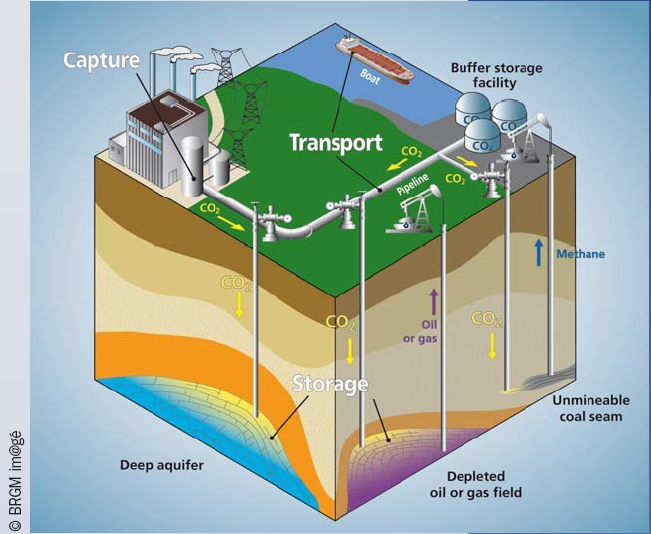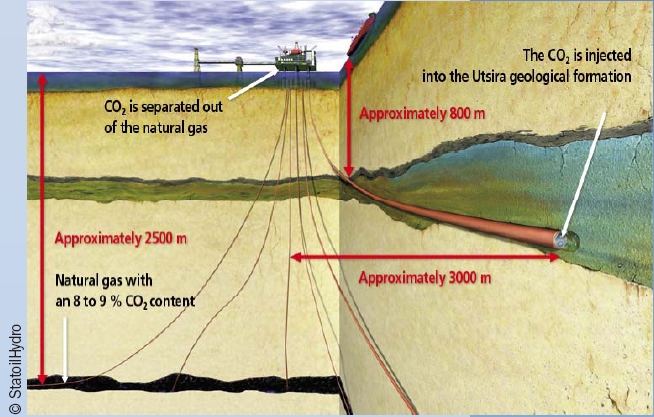
|
Climate change
and the need for CO2 geological storage
|
Mankind is releasing excess CO2 into the atmosphere
It is now accepted that human activities are disturbing the carbon cycle of our planet. Prior to the industrial revolution and extending back some 10,000 years, this finely balanced cycle, involving the natural exchange of carbon between the geosphere, the biosphere, the oceans and the atmosphere, resulted in a low range of CO2 concentrations in the atmosphere (around 280 ppm, i.e. 0.028%). However, over the past 250 years, our prolific burning of fossil fuels (coal, oil, gas) for power production, heating, industry and transportation, has incessantly raised the amount of CO2 emitted into the atmosphere (Fig. 1). About half of this human-induced excess has been reabsorbed by vegetation and dissolved in the oceans, the latter causing acidification and its associated potentially negative impacts on marine plants and animals. The remainder has accumulated in the atmosphere where it contributes to climate change, because CO2 is a greenhouse gas that traps part of the sun’s heat, causing the earth’s surface to warm. Immediate radical action is needed to stop today's atmospheric CO2 concentration of 387 ppm (already a +38% increase compared to pre-industrial levels) from rising beyond the critical level of 450 ppm in the coming decades. Experts worldwide agree that above this level, it may no longer be possible to avert the most drastic consequences.

|
Figure 1
Global CO2 emissions linked to man's activities amount to 30 billion tons (Gt) per year, corresponding to 8.1 Gt of carbon:
6.5 Gt from burning fossil fuels and 1.6 Gt from deforestation and agricultural practices.
|
Returning the carbon back into the ground
Our world has been heavily dependent on fossil fuels since the start of the Industrial Age in the 1750s, so it is not surprising that the transformation of our society into one based on climate-friendly energy sources will take both time and money. What we need is a short-term solution that will help reduce our dependence on fossil fuels by using them in a non-polluting way as a first step, thus giving us the time needed to develop technologies and infrastructure for a renewable-energy future. One such option is to create a closed loop in the energy production system, whereby the carbon extracted from the ground originally in the form of gas, oil, and coal is returned back again in the form of CO2. Interestingly, underground storage of CO2 is not a human invention, but a totally natural, widespread phenomenon manifested by CO2 reservoirs that have existed for thousands to millions of years. One such example is the series of eight natural CO2 reservoirs in south-eastern France discovered during oil exploration in the 1960s (Fig. 2). These and many other natural sites throughout the world prove that geological formations are able to store CO2 efficiently and safely for extremely long periods of time.

|
Figure 2
France's carbogaseous province.
 Natural CO2 fields Natural CO2 fields
 Exploited carbogaseous waters (drinking water, spa) Exploited carbogaseous waters (drinking water, spa)
|
CO2 Capture and Storage: a promising mitigation pathway
Amongst the spectrum of measures that need to be urgently implemented to mitigate climate change and ocean acidification, CO2 Capture and Storage (CCS*) can play a decisive role as it could contribute 33% of the CO2 reduction needed by 2050. CCS involves capturing CO2 at coal- or gas-fired power stations and industrial facilities (steel mills, cement plants, refineries, etc.), transporting it by pipeline or ship to a storage location, and injecting it via a well* into a suitable geological formation for long-term storage (Fig. 3). In view of the growing world population and rising energy demand in developing countries, as well as the current lack of large-scale alternative 'clean' energy sources, the continued use of fossil fuels is inevitable in the short term. Hand in hand with CCS, however, humanity could progress in an environmentally friendly way while at the same time creating a bridge to a worldwide economy based on sustainable energy production.

|
Figure 3
At power plants, the CO2 is captured by separating it out from the other gases. It is then compressed and transported via pipeline or ship to its geological storage site: deep saline aquifers, depleted oil and gas fields, unmineable coal seams.
|
Worldwide development of CCS is flourishing
Major research programmes on CCS have been conducted in Europe, the United States, Canada, Australia and Japan since the 1990’s. Much knowledge has already been acquired at the world’s first large-scale demonstration projects, where CO2 has been injected deep underground for several years: Sleipner in Norway (about 1Mt/year since 1996) (Fig. 4), Weyburn in Canada (about 1.8Mt/year since 2000), and In Salah in Algeria (about 1Mt/year since 2004). International collaboration on CO2 storage research, fostered by IEA-GHG* and CSLF*, at these and other sites has been particularly important in extending our understanding and developing a worldwide scientific community that is addressing this issue. An excellent example is the IPCC* special report on CO2 capture and storage (2005), which describes the current state of knowledge and the obstacles that must be overcome to allow the widespread implementation of this technology. Robust technical expertise already exists, and the world is now confidently moving into the demonstration phase. In addition to technical developments, legislative, regulatory, economic and political frameworks are being drawn up, and social perception and support are being assessed. In Europe, the goal is to have as many as 12 large-scale demonstration projects up-and-running by 2015 to enable widespread commercial deployment by 2020. For this purpose, in January 2008, the European Commission issued the “Climate action and renewable energy package”, which proposes a Directive on CO2 geological storage and other measures to promote the development and safe use of CCS.

|
Figure 4
A vertical cross-section of the Sleipner site, Norway.
The natural gas, extracted at a depth of 2500 m, contains several percent of CO2 that needs to be removed to comply with commercial standards. Instead of releasing it into the atmosphere, the captured CO2 is injected at approximately 1000-m depth into the sandy Utsira aquifer*.
|
Key questions on CO2 geological storage
CO2GeoNet Network of Excellence was created under the auspices of the European Commission as a group of research institutions capable of maintaining Europe at the forefront of large-scale international research. One of CO2GeoNet's goals is the communication of clear scientific information on the technical aspects of CO2 geological storage. To encourage dialogue on the essential aspects of this vitally important technology, CO2GeoNet researchers have prepared basic answers to several frequently asked questions. In the following pages, you will find explanations as to how CO2 geological storage can be carried out, under what circumstances it is possible, and what the criteria are for its safe and efficient implementation.
Source: The European Network of Excellence on the Geological Storage of CO2
<< Previous page
---
Next page >>
TOP
|





